Day 34/40 Days of K8s: Upgrading a Multi Node Kubernetes Cluster With Kubeadm !!
 Gopi Vivek Manne
Gopi Vivek Manne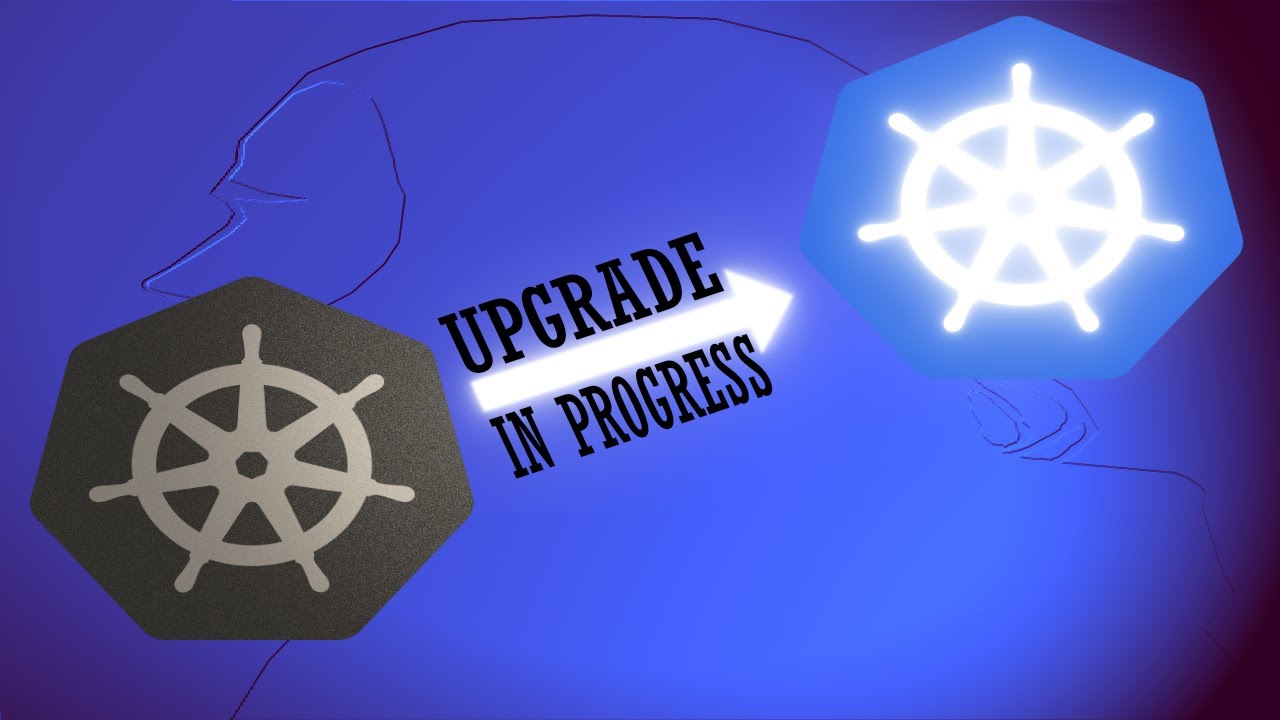
Kubernetes Cluster Upgrade Guide
❓Understanding Kubernetes Versions
Version format:
major.minor.patch(ex: 1.30.2)Kubernetes supports only the latest 3 minor versions.
Upgrades are typically done one minor version at a time.
Example Cluster
Let's assume we have multi node kubeadm cluster, 1 master node (control plane) and 2 worker nodes on EC2s.
Generally, we will have Multiple master nodes to ensure high availability.
Upgrading Order
Primary control plane
Other control plane nodes (if any)
Worker nodes
Please follow this thread of official kubernetes documentation to understand additional details: https://kubernetes.io/docs/tasks/administer-cluster/kubeadm/kubeadm-upgrade/
Why This Order?
Ensures at least one master is always running to maintain high availability and not disrupt cluster management functions.
Reason: If the control plane is down, all cluster management and administrative activities halt because the controller manager, API server, and scheduler are unavailable, preventing management of worker nodes. However, this does not affect the running applications.
Upgrading Nodes
Process for Each Node:
Drain the node
Evicts all pods from the node.
Reschedules pods on other nodes.
Marks node as cordoned (unavailable for scheduling).
Upgrade the node
Uncordon the node (make available for scheduling)
Upgrade Strategies
All at Once
Upgrade all worker nodes simultaneously
Pros: Quick and easy
Cons: Potential downtime of application, not ideal for production setup.
Rolling Update
Upgrade nodes one after another.
Pros: Minimal to no downtime, as other nodes remain available.
Cons: Takes longer to complete but very to no impact of downtime.
Blue/Green
Create a new/identical infrastructure with the upgraded version
Join new worker nodes to control plane
Remove old infrastructure
Pros: Quick, no downtime, seamless(especially when we are using public clouds)
Cons: Requires additional resources temporarily(hard in case of private cloud).
Component Version Compatibility
Control plane components (API server, Scheduler, Controller Manager): Can be one version behind the Kubernetes version.
Kubelet and kubectl: Can be up to two versions behind.
Best practice: Keep all components at the same version
Remember: Always backup your cluster data before performing any upgrades!
Hands-on
Ensure we're using the community-owned package repositories (
pkgs.k8s.io), we need to enable the package repository for the desired Kubernetes minor release.Follow this thread of k8s documentation to understand how to verify the k8s package repositories are used: https://kubernetes.io/docs/tasks/administer-cluster/kubeadm/change-package-repository/

Switching to another Kubernetes package repository
This step should be done upon upgrading from one to another Kubernetes minor release in order to get access to the packages of the desired Kubernetes minor version.
sudo vi /etc/apt/sources.list.d/kubernetes.listI have edited the version to v1.30 as shown below

Determine which version to upgrade to

This shows that version v1.30 is ready to be upgraded now.
Upgrading primary Control plane node
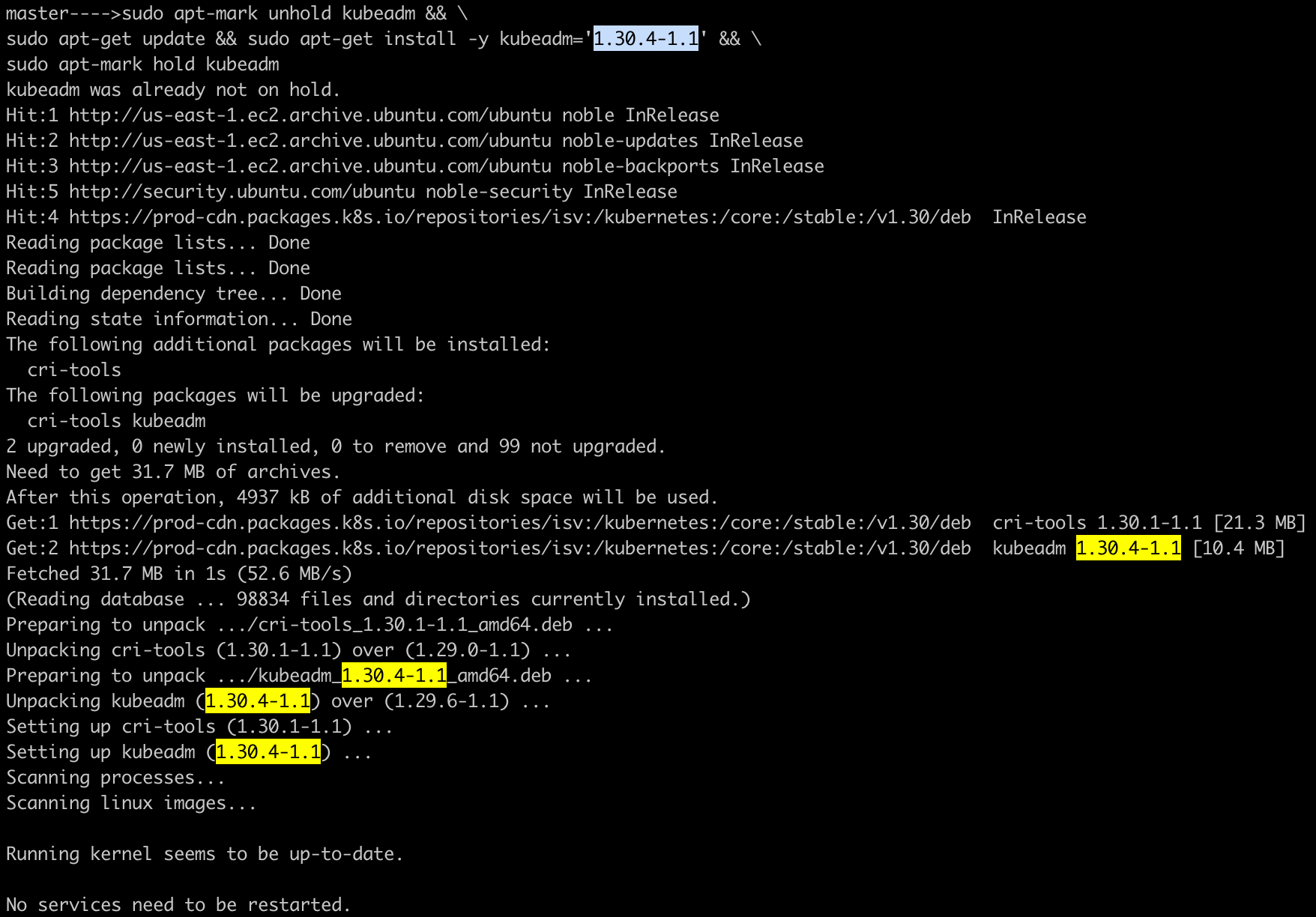
Verify the kubeadm version:

Verify the upgrade plan
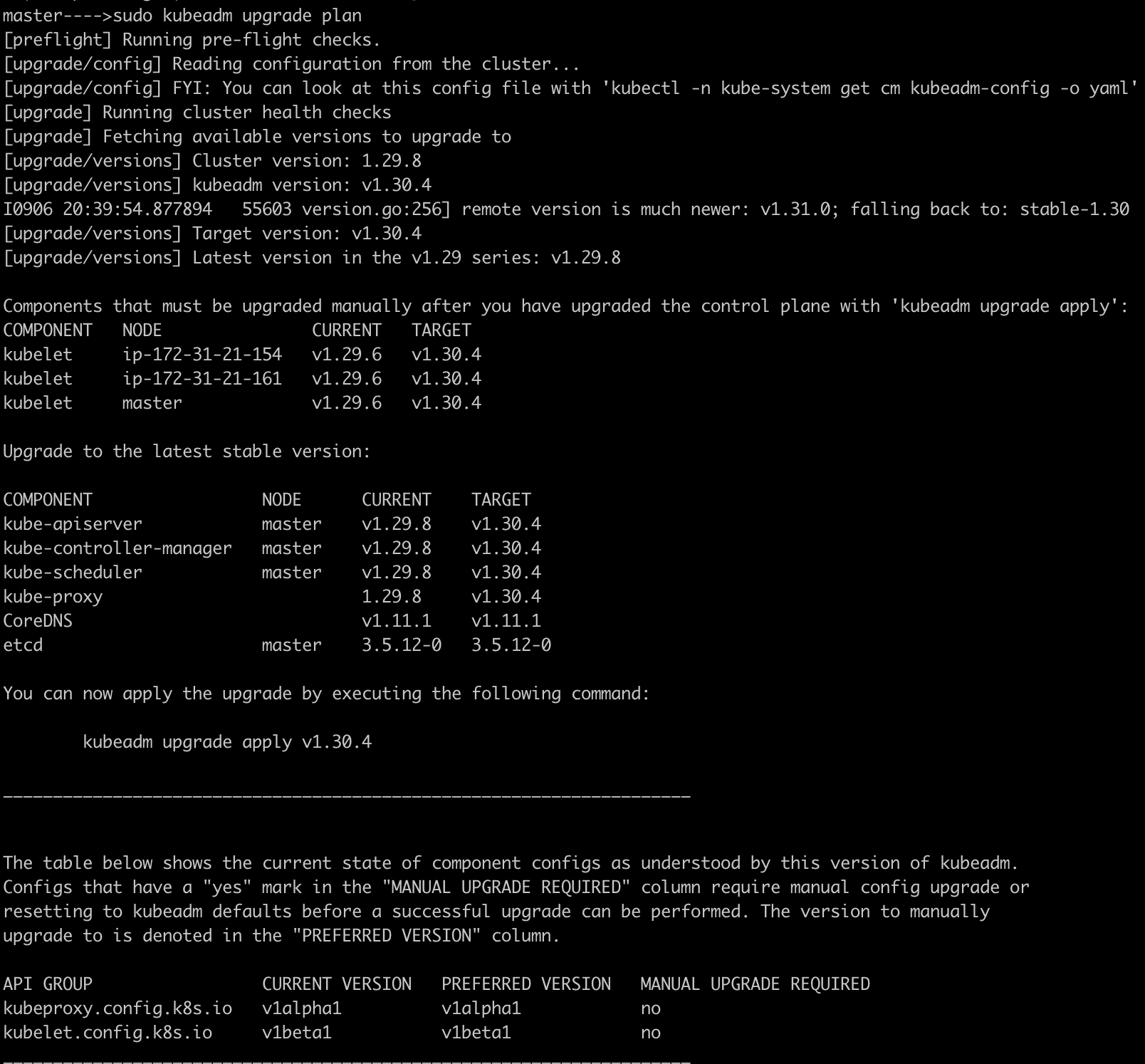
Now, upgrade the version of kubeadm using the command like
sudo kubeadm upgrade apply v1.30.4
Drain the node: Prepare the node for maintenance by marking it unschedulable and evicting the workloads.

Upgrade the kubelet and kubectl
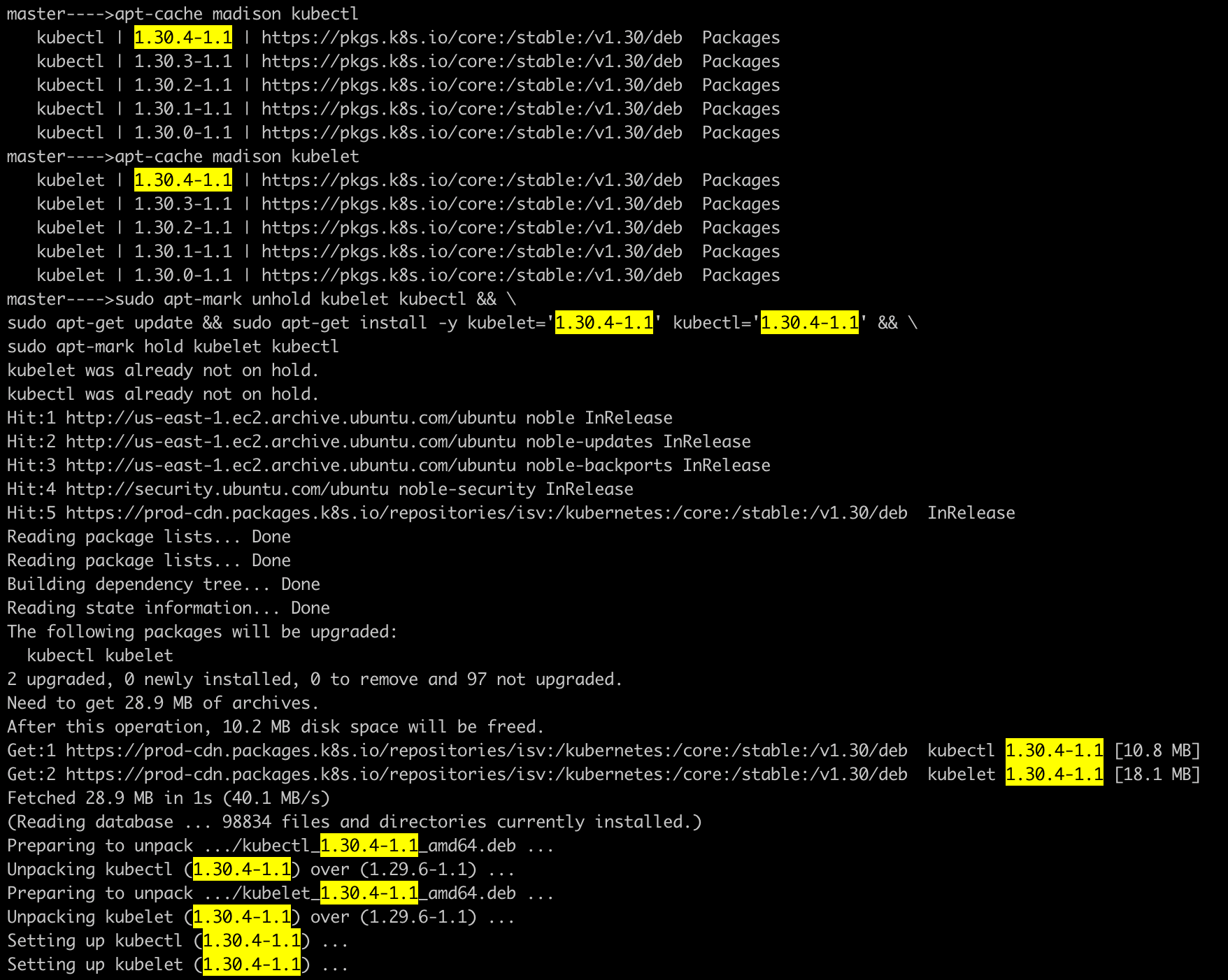
Restart the kubelet

Uncordon the node
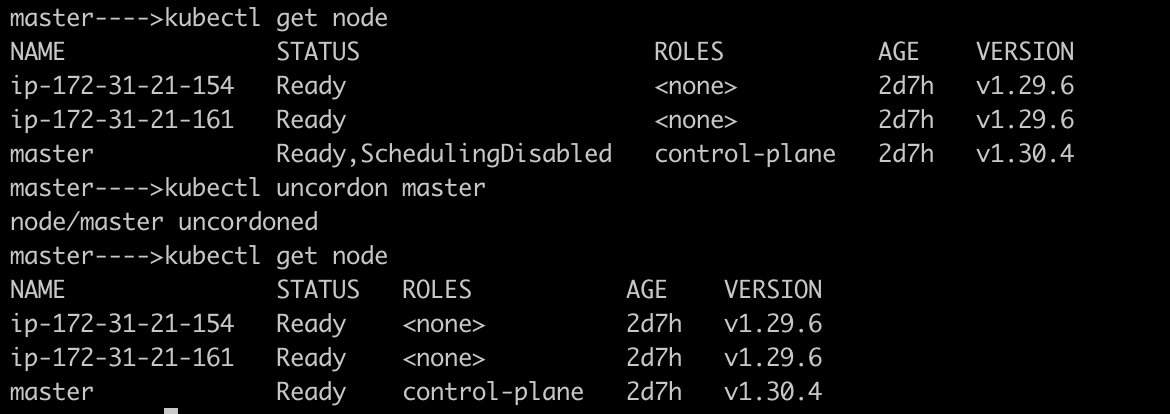
This clearly shows that master node has been upgraded to a new version
v1.30.4then it is uncordoned to make it allow any pods to be scheduled on it.
Upgrading worker nodes
Although we have different strategies of upgrading the node, I chose to use Rolling upgrade for now
Repeat the steps from 1-11 on each worker node
Here are the commands that should be followed in a sequence while upgrading worker nodes
kubectl get nodes
sudo vi /etc/apt/sources.list.d/kubernetes.list
sudo apt update && sudo apt-cache madison kubeadm
kubeadm version
sudo apt-mark unhold kubeadm && sudo apt-get update && sudo apt-get install -y kubeadm='1.30.4-1.1' && sudo apt-mark hold kubeadm
kubeadm version
sudo kubeadm upgrade node
kubectl drain ip-172-31-21-161 --ignore-daemonsets
sudo apt-mark unhold kubelet kubectl && sudo apt-get update && sudo apt-get install -y kubelet='1.30.4-1.1' kubectl='1.30.4-1.1' && sudo apt-mark hold kubelet kubectl
sudo systemctl daemon-reload
sudo systemctl restart kubelet
sudo systemctl status kubelet
kubelet --version
kubectl uncordon ip-172-31-21-161
kubectl get nodes

From the above picture,This Clearly shows that all our nodes have been successfully upgraded to the version v1.30.4.
Common Questions
Why Upgrading
kubeadmon Worker Nodes once we already did on control-plane?It's important to upgrade
kubeadmon the worker nodes as it ensures compatibility with the control plane by updating the necessary configurations on the worker node. Once compatibility is confirmed, you can proceed to upgradekubeletandkubectlafter draining the node.Why Run
sudo kubeadm upgrade nodeon Worker Nodes?This process ensures that worker nodes are properly synced with the control plane and running the desired Kubernetes version without disrupting your applications.
#Kubernetes #Kubeadm #UpgradingCluster #Multinodecluster #40DaysofKubernetes #CKASeries
Subscribe to my newsletter
Read articles from Gopi Vivek Manne directly inside your inbox. Subscribe to the newsletter, and don't miss out.
Written by

Gopi Vivek Manne
Gopi Vivek Manne
I'm Gopi Vivek Manne, a passionate DevOps Cloud Engineer with a strong focus on AWS cloud migrations. I have expertise in a range of technologies, including AWS, Linux, Jenkins, Bitbucket, GitHub Actions, Terraform, Docker, Kubernetes, Ansible, SonarQube, JUnit, AppScan, Prometheus, Grafana, Zabbix, and container orchestration. I'm constantly learning and exploring new ways to optimize and automate workflows, and I enjoy sharing my experiences and knowledge with others in the tech community. Follow me for insights, tips, and best practices on all things DevOps and cloud engineering!